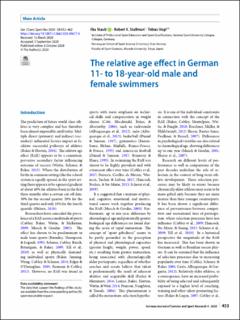| dc.contributor.author | Staub, Ilka | |
| dc.contributor.author | Stallman, Robert Keig | |
| dc.contributor.author | Vogt, Tobias | |
| dc.date.accessioned | 2021-03-04T15:00:55Z | |
| dc.date.available | 2021-03-04T15:00:55Z | |
| dc.date.created | 2021-01-22T13:08:50Z | |
| dc.date.issued | 2020 | |
| dc.identifier.citation | German Journal of Exercise and Sport Research. 2020, 50(4), 453-462. | en_US |
| dc.identifier.issn | 2509-3142 | |
| dc.identifier.uri | https://hdl.handle.net/11250/2731727 | |
| dc.description | This article is licensed under a Creative Commons Attribution 4.0 International License, which permits use, sharing, adaptation, distribution and reproduction in any medium or format, as long as you give appropriate credit to the original author(s) and the source, provide a link to the Creative Commons licence, and indicate if changes were made. The images or other third party material in this article are included in the article’s Creative Commons licence, unless indicated otherwise in a credit line to the material. If material is not included in the article’s Creative Commons licence and your intended use is not permitted by statutory regulation or exceeds the permitted use, you will need to obtain permission directly from the copyright holder. | en_US |
| dc.description.abstract | Relatively older athletes have a greater probability of being selected and subsequently exposed to a higher level of coaching, training and other talent-promoting factors. Grouping by chronological age is, therefore, considered to be one of the weaknesses in talent identification. A large number of studies have confirmed the prevalence of the relative age effect (RAE) across various sports, including swimming. This investigation aims to quantify the prevalence, magnitude and transient pattern of the RAE according to sex and events across German swimmers. The RAE was examined top-100 ranked swimmers (2004–2013) according to birth month, of three cohorts (born 1993–1995; n = 3630) for the age groups 11–18. The Χ2 tests and Cramer’s V estimated effect sizes; odd’s ratios and confidence intervals calculated relative discrepancies between the quartiles. The RAE is significantly present over all events for female swimmers until 13–15 and for males until 16–18 years of age. Effect sizes were moderate until 12/13 years of age for females and 14/15 years of age for males. No inverted effects were visible. Compared to previous reports on Australian as well as Portuguese cohorts, the RAE was prevalent over a longer time period. Therefore, the impact of negative outcomes from RAE appears to be greater among German age group swimmers. | en_US |
| dc.language.iso | eng | en_US |
| dc.subject | long-term athlete development | en_US |
| dc.subject | talent identification | en_US |
| dc.subject | youth sport | en_US |
| dc.subject | children | en_US |
| dc.subject | athletic performance | en_US |
| dc.title | The relative age effect in German 11- to 18-year-old male and female swimmers | en_US |
| dc.type | Peer reviewed | en_US |
| dc.type | Journal article | en_US |
| dc.description.version | publishedVersion | en_US |
| dc.rights.holder | © The Author(s) 2020 | en_US |
| dc.source.pagenumber | 453-462 | en_US |
| dc.source.volume | 50 | en_US |
| dc.source.journal | German Journal of Exercise and Sport Research | en_US |
| dc.source.issue | 4 | en_US |
| dc.identifier.doi | 10.1007/s12662-020-00677-4 | |
| dc.identifier.cristin | 1877137 | |
| dc.description.localcode | Institutt for fysisk prestasjonsevne / Department of Physical Performance | en_US |
| cristin.ispublished | true | |
| cristin.fulltext | original | |
| cristin.qualitycode | 1 | |
